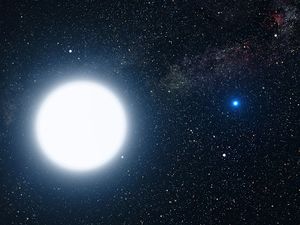User:Bizzeebeever/Articles/UnNews:Star biggest and brightest discovered since...four days ago
UNIVERSITY OF CALIFORNIA, BERKLEY, California — Twenty million, nine hundred and ninety-nine thousand, nine hundred ninety nine years and three hundred sixty-four days ago in the Pinwheel Galaxy (a spiral-armed neighbor of our own Milky Way), an old, dim star had a very good day. It woke up, yawned, stretched, and then carried on as it was wont to do, putting out a pittance of light into a vastly empty universe utterly unappreciative of its efforts, without asking or expecting anything in return.
On Aug. 23, Peter Nugent had a very bad day. The Lawrence Berkeley National Laboratory astrophysicist spotted the star in images from a robotic telescope, and proceeded to share his discovery with everyone in his life — his colleagues, friends, family, passing acquaintances, neighbors, and even complete strangers on the Internet. The star, however, was so dreadfully far away — in cosmic terms — and was otherwise so completely mundane, that astronomers are calling it the least important discovery of a generation, and have taken to mocking Nugent mercilessly on his Facebook page, his Twitter page, his Foursquare page, and, in fact, via anonymous emails, obscene phone calls, graffiti scrawled on the walls of the office bathroom, and on missives attached to bricks, which they then hurl through his office window.
Telescopes around the world and beyond, including the Hubble Space Telescope, swiveled to take a peek — at just about anything else in the sky that could be considered more interesting. (Astronomers estimate this as being roughly equal to "everything.")
"This i...i...is a rather tedious non-event," said Ken Sembach of the Space Telescope Science Institute in Baltimore, stifling a yawn. "As a matter of fact, using the word 'event' in the same sentence with it rather cheapens the meaning of the word, just by association. I mean, no one in their right mind wants to be associated with the discovery of this thing."
Nugent, excitedly discussing his discovery from a rubber room at a local psychiatric hospital, said the light from the star will continue to faintly brighten the cosmic darkness for quite a while—"Eons, maybe. Or forever."—before petering out, or perhaps exploding. ("Only perhaps, though.") The star, just above the handle of the Big Dipper, is approximately as large as a speck of dust viewed from three miles away, and so will be utterly invisible to backyard astronomers wielding binoculars, who are advised to ignore it.
The last discovery to generate such a widely-distributed "meh!" came approximately four days earlier, when Nugent announced his discovery of Oph 162225-240515, an insignificant binary brown dwarf system, somewhere in the constellation Ophiuchus.
"This is not an every-year event, these days," said Robert Kirshner, a Harvard University star hunter. "This is an every-day-or-four event, and frankly, we're rather tired of this Nugent fellow jumping up and down and wetting his pants with excitement, every time he finds a new star."
Sources[edit | edit source]
- Brian Vestag "Star discovered, no one cares" Washington Post, September 3, 2011

